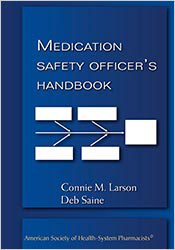The information below is intended to be dynamic; therefore, the ASHP Center on Patient Safety encourages your feedback so that we can improve this document.
To provide our members with timely information and guidance on topics related to safety and quality in the medication-use process, the American Society of Health-System Pharmacists Center on Patient Safety developed this list of suggestions and questions to consider before purchasing a computerized prescriber-order entry (CPOE) system. This list, while not exhaustive, is intended as a tool to support pharmacists’ immediate need to act on this issue.
Where to Start
- Commit from the beginning to work in an interdisciplinary manner.
- Identify an interdisciplinary team of key individuals who will interact with the CPOE system.
- Focus on the system features that will add value for patients. Ask team members to help convince peers that having a CPOE system is in their best interest.
- Do not forget to include key players such as the chief information officer, information technology (IT) staff, risk managers, and medical staff.
- Lead, but make the overall project a team effort.
- Outline the goals for CPOE (e.g., to improve safety, decrease costs, eliminate handwritten orders). You may have primary and secondary goals. Knowing and prioritizing your goals and their relative importance will be very valuable during implementation of the system. You may not be able to satisfy every identified goal. Your implementation team will appreciate the clarity of goals as the inevitable questions arise.
- Develop your wish list of desired features and determine which ones, given budgetary constraints, are practical. Find out about successes and failures by talking with individuals from other organizations who have implemented a CPOE system. Will the new system interface with your current information system? To what extent will customization be required?
- Do your homework at the beginning and develop a business case for the new system in order to garner resources. Perhaps include a technology-specific section that addresses the safe use of computers and automation in the entire medication-use system.
- Do not try to justify the CPOE system by promising that it will allow the institution to decrease the number of staff members, because it most likely will not. A good system, though, should enhance safety and improve efficiency by decreasing the number of repetitive and mundane tasks. You may see the number of steps in the medication-use process decrease, but the remaining steps will require highly-trained, competent personnel who understand and can deal with the complexity and importance of those steps.
Assume that you do not know all the answers, and keep the culture of your organization at the forefront of this decision-making process. Consider using an outside party to identify- the organizational barriers to implementing a CPOE system, and
- ways to overcome those barriers so that your new CPOE system will do what you expect it to do.
- Beware of cumbersome features that may provoke users to override features of the CPOE system.
- As soon as the system is installed, it is important to commit in a meaningful way to its continual monitoring and improvement. Your health care environment is a dynamic one in which opportunities for new (and some old, but as yet unidentified) errors will likely arise. Identify key measures that will help you determine whether your CPOE system is really improving safety and quality and reducing costs.
General Questions to Consider When Purchasing a CPOE System
- Is the system truly designed for prescriber-only order entry (i.e., not simply a pharmacy order entry system to which prescribers are given access to enter orders)?
- Does the system prevent access by nonprescribers?
- Does the system integrate with the existing pharmacy order entry system, or must orders be reentered into the pharmacy system? (Remember that transcription is a frequent source of errors.) Does the CPOE system integrate with the current information system? How many customizations and patches will be needed?
- What are the elements that the prescriber must enter (e.g., drug name, dosage form, dose, strength, duration of therapy, directions for administration, and quantity for outpatient prescriptions)?
- What are the elements that must be entered by the pharmacist who reviews the prescriber’s order?
- Does the system allow for off-site order entry, including from a prescriber’s home or office? Does the system allow for direct entry from a hand-held device?
- Does the system store and allow access to patient information from previous hospital admissions and clinic visits?
- To what extent does the system recognize only a standardized format for order entry (e.g., software-defined or institutionally defined fields)? Is “free text” entry an option? Can you foresee a situation in which pharmacy would have to reenter an order because the system lacked a standardized format? (Such reentry may be desirable.)
- Is the system capable of wireless use without installation of additional equipment, or is it upgradable to allow for wireless, remote order entry?
- Does the system require the use of passwords? If so, can the system share passwords with other password-requiring systems in the organization? Or, does the system identify users on the basis of a measurable biological feature (e.g., thumbprint, retinal scan), thereby eliminating the need for passwords?
- Can the system be used to manage the formulary?
- Can the system accommodate multiple formularies? If so, how does it deal with multiple formularies?
- What order-entry user interfaces are available (e.g., touchscreen, voice recognition, keypad)?
- Does the system have a feature that allows for input of notes about procedures, admissions, and discharges?
- Does the system prevent the prescriber from using abbreviations and mnemonics during order entry, which are proven sources of errors?
- Does the system automatically check medication orders for elements such as:
- Dose ranges, including high-dose, low-dose, and lifetime doses for antineoplastic agents?
- Pediatric and adult dosages of the same drug?
- Dosages of critical care drugs?
- Drug-drug interactions?
- Duplicate drugs?
- Drug allergies?
- Does the system check for interactions with and contraindications to the use of dietary supplements?
- Will the system alert the prescriber to dangerous orders?
- Does the system display the cost of a therapy and provide suggestions for less-costly therapeutic alternatives?
- Can orders for medical procedures also be entered and integrated into the system?
- How are nurses notified of a new, discontinued, or changed medication order?
- How is the pharmacy notified that a nurse has entered a change in the medication administration schedule?
- Does the system handle orders for all medications and intravenous fluids including parenteral nutrition admixtures?
- How does the system notify pharmacy and nursing of STAT and NOW orders?
- How are medication administration records generated?
- Does the system provide up-to-date, reliable drug information at the user interface?
- How often is drug information updated by the computer company?
- Can the institution update the drug information?
- What is the quality of the drug information that the CPOE system uses to check for drug interactions?
- Does the CPOE system’s platform support an electronic medical record and real-time electronic charting?
- Does the CPOE system integrate with the existing laboratory system to show real-time test results? Will the system cross-reference laboratory data with drug orders (e.g., allow the user to view an antimicrobial order and the results of culture and susceptibility testing and determination of minimum inhibitory concentrations)?
- Does the CPOE system support machine-readable coding (e.g., bar codes)?
- What decision-support features are available (e.g., order sets for individual or groups of prescribers, standardized admission or discharge orders, therapeutic guidelines, policies and procedures, standard orders, cost information, medical literature citations)?
- Does the system display pop-up reminders for laboratory monitoring, standard orders, and other user-defined reminders?
- Before installation begins, the system will need to be extensively tested for accuracy and safety. How will the vendor support this testing?
- Ask the vendor whether it employs full-time human factors engineers as part of the CPOE system-design team. The ideal CPOE system should have been designed, evaluated, and tested by practicing professionals (e.g., pharmacists, physicians, nurses, IT staff) and human factors engineers. Well-designed user interfaces play a key role in ensuring safety.
- How will the medication-use system safely operate when the CPOE system is not usable (e.g., emergency, planned downtime for maintenance)?


